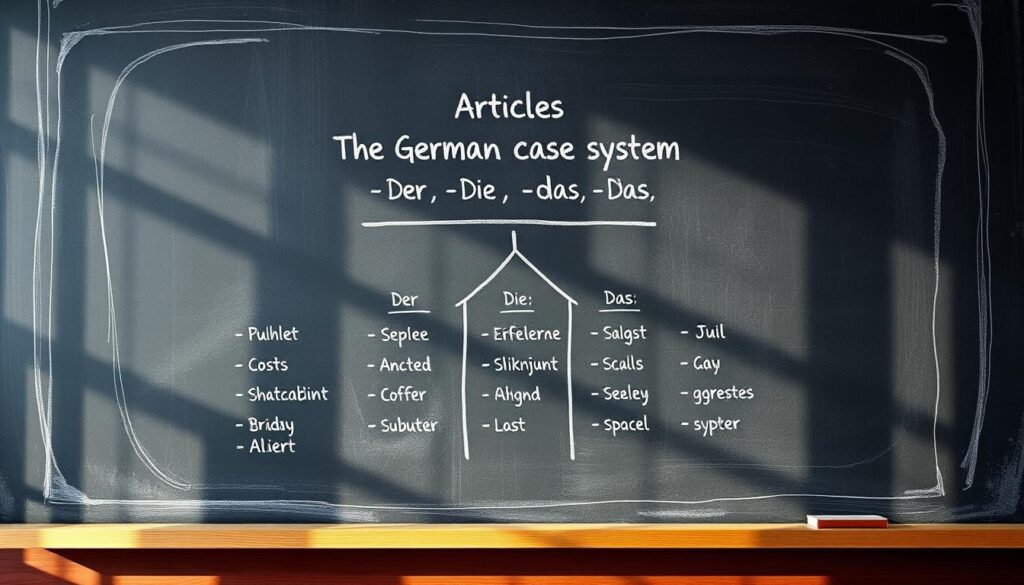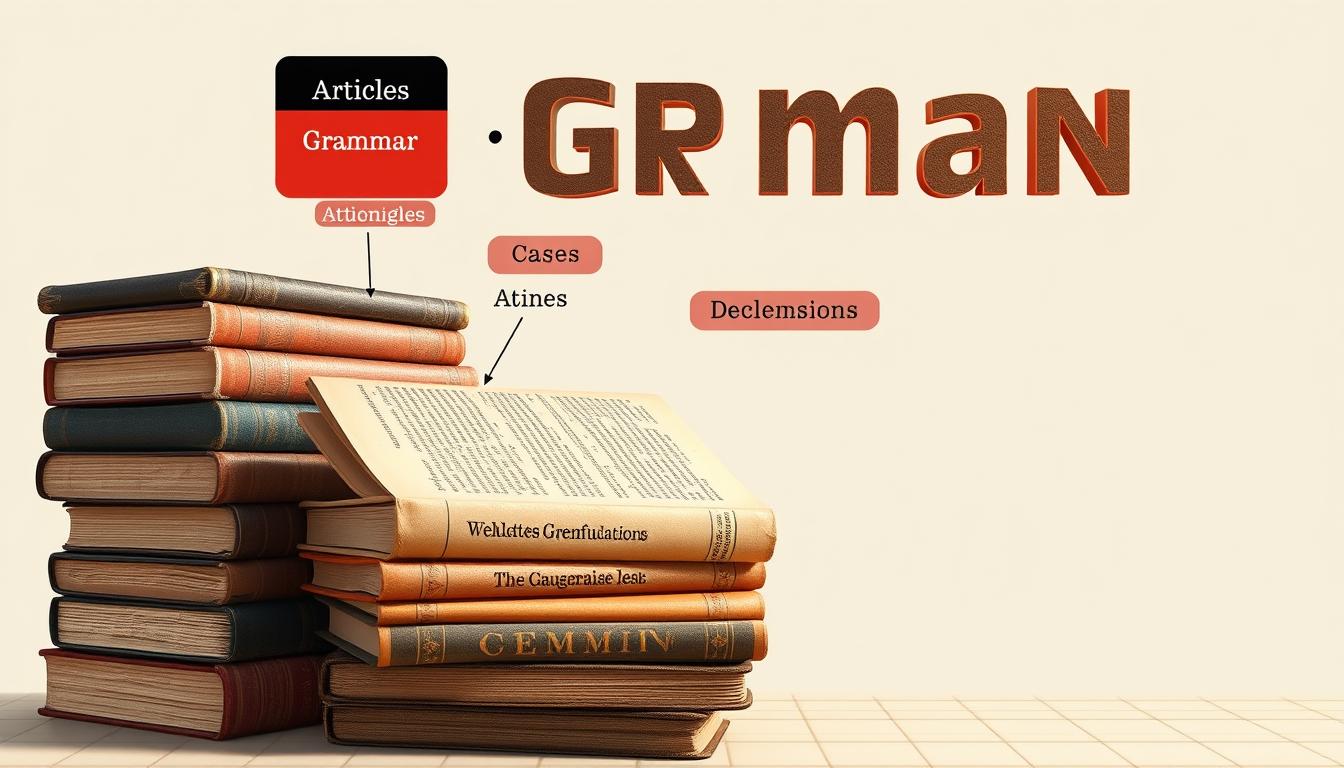Mastering the basics of German grammar can be a challenging but rewarding experience for language learners. One of the fundamental aspects to grasp is the correct usage of der, die, das, which are the German articles that can often confuse beginners due to their various applications.
The proper use of these articles is crucial for effective communication in German. Understanding the rules that govern their usage can significantly enhance one’s ability to express themselves clearly and accurately.
Table of Contents
ToggleKey Takeaways
- Understanding the difference between der, die, and das is crucial for mastering German grammar.
- German articles are essential for clear and accurate communication.
- The rules governing der, die, das usage can be complex but are vital for language learners.
- Correct usage of German articles enhances overall language proficiency.
- Simplifying German grammar rules starts with understanding der, die, das.
Understanding the Basics of German Articles
The German language relies heavily on articles to convey meaning and context, making them a fundamental aspect of language learning. Articles in German are used to specify whether a noun is specific or general, and they play a crucial role in understanding the language’s grammar and syntax.
What Are Articles and Why They Matter in German
Articles are words that precede nouns and indicate their type and reference in a sentence. In German, articles are essential for conveying the correct meaning and context of a sentence. They help to clarify whether a noun is specific or general, and they provide important information about the noun’s gender, number, and case.
The Three Definite Articles: Der, Die, Das
German has three definite articles: der (masculine), die (feminine and plural), and das (neuter). These articles are used to refer to specific nouns. For example, “der Hund” (the dog), “die Katze” (the cat), and “das Haus” (the house).
The Indefinite Articles: Ein, Eine, Ein
In addition to definite articles, German also has indefinite articles: ein (masculine and neuter) and eine (feminine). These are used to refer to non-specific nouns. For instance, “ein Mann” (a man), “eine Frau” (a woman), and “ein Kind” (a child).
| Article Type | Masculine | Feminine | Neuter | Plural |
|---|---|---|---|---|
| Definite | der | die | das | die |
| Indefinite | ein | eine | ein | keine (not applicable) |
German Articles Explained: The Gender System
Understanding the German gender system is crucial for mastering the language’s article usage. In German, every noun is assigned a gender, which can be masculine, feminine, or neuter. This gender assignment significantly influences the articles used with these nouns.
Masculine, Feminine, and Neuter Nouns
German nouns are categorized into three genders:
- Masculine nouns (der): Typically, nouns ending in -er, -el, or -ling are masculine.
- Feminine nouns (die): Nouns ending in -in, -ung, or -heit are usually feminine.
- Neuter nouns (das): Nouns starting with Ge-, ending in -chen or -lein, and most countries or cities are neuter.
Why German Has Three Genders
The three-gender system in German is a legacy from Old High German and is shared with other Germanic languages. While it may seem complex, understanding the gender of a noun can provide clues about its meaning and grammatical function. For instance, professions or occupations often have different forms based on gender.
How Gender Affects Article Usage
The gender of a noun directly determines the article used. For example:
- Masculine nouns use “der” (the) in the nominative case.
- Feminine nouns use “die” (the).
- Neuter nouns use “das” (the).
This means that knowing the gender of a noun is essential for correct article usage. For learners, mastering the gender system is a key step in becoming proficient in German.
By understanding and applying the rules of the German gender system, learners can improve their grasp of german language articles and enhance their overall language skills. Practice and exposure to the language will help in how to use articles in german effectively.
Rules for Determining Gender in German
The gender of German nouns is not random; there are semantic and morphological rules to follow. Understanding these rules can significantly simplify the learning process for German language learners.
Semantic Rules: Meaning-Based Gender Assignment
Semantic rules relate to the meaning of the nouns. For instance, nouns related to males are typically masculine, while those related to females are feminine. Examples include der Vater (the father) and die Mutter (the mother). Additionally, the names of days, months, and seasons are generally masculine, such as der Montag (Monday) and der Sommer (summer).
Morphological Rules: Word Endings That Indicate Gender
Morphological rules concern the form and structure of the nouns. Certain endings can indicate the gender of a noun. For example, nouns ending in -ung, -schaft, or -heit are usually feminine, such as die Hoffnung (the hope) and die Freundschaft (the friendship). Nouns ending in -chen or -lein are typically neuter, like das Mädchen (the girl) and das Fräulein (the young lady).
Understanding these morphological rules can help learners predict the gender of many nouns, though it’s essential to remember that there are exceptions.
Exceptions to Remember
Despite the rules, there are numerous exceptions in German. For example, das Mädchen is neuter despite referring to a female. It’s crucial to learn these exceptions to avoid confusion. Keeping a list of common exceptions can be a helpful study aid.
By combining semantic and morphological rules with practice and memorization, learners can improve their grasp of German grammar rules. Applying these tips can make learning German more efficient and enjoyable.
For more German language tips, it’s advisable to practice regularly and engage with the language through reading, writing, and speaking. This active engagement will reinforce the rules and exceptions, making them second nature.
The German Case System and Articles
To grasp German grammar fully, one must understand how the case system influences article usage. The German case system is a fundamental aspect of the language, determining how nouns, pronouns, and articles change based on their grammatical function within a sentence.
Nominative Case: The Subject
The nominative case is used for the subject of the sentence. For example, “Der Hund läuft” (The dog runs), where “der Hund” is in the nominative case. Here, “der” is the article used for masculine nouns.
Accusative Case: The Direct Object
In the accusative case, the article changes for masculine nouns. For instance, “Ich sehe den Hund” (I see the dog), where “den Hund” is in the accusative case, and “den” is the article used.

Dative Case: The Indirect Object
The dative case is used for the indirect object. For example, “Ich gebe dem Hund einen Knochen” (I give the dog a bone), where “dem Hund” is in the dative case, and “dem” is the article.
Genitive Case: Possession
The genitive case indicates possession. For example, “Das ist das Buch des Mannes” (That is the man’s book), where “des Mannes” is in the genitive case, showing possession.
Understanding these cases and how they affect articles is crucial for effective communication in German. By mastering the case system, learners can improve their German language skills significantly.
Definite Article Declensions Across Cases
To speak and write German correctly, it’s essential to grasp how ‘der, die, das’ change across the four cases. The definite article’s form changes based on the grammatical case it is used in, whether it’s nominative, accusative, dative, or genitive.
Der, Die, Das in Nominative Case
In the nominative case, the subject of the sentence is referenced. Here, the definite articles remain ‘der’ for masculine nouns, ‘die’ for feminine and plural nouns, and ‘das’ for neuter nouns.
Den, Die, Das in Accusative Case
The accusative case is used for the direct object. Masculine nouns change ‘der’ to ‘den’, while ‘die’ and ‘das’ remain the same for feminine/plural and neuter nouns, respectively.
Dem, Der, Dem in Dative Case
In the dative case, indicating the indirect object, ‘der’ becomes ‘dem’ for masculine and neuter nouns, and ‘die’ becomes ‘der’ for feminine nouns.
Des, Der, Des in Genitive Case
The genitive case shows possession. Here, ‘der’ changes to ‘des’ for masculine and neuter nouns, and ‘die’ becomes ‘der’ for feminine nouns.
Understanding these changes is key to mastering German grammar. Let’s summarize the declension of definite articles across the four cases in the following table:
| Case | Masculine | Feminine | Neuter | Plural |
|---|---|---|---|---|
| Nominative | der | die | das | die |
| Accusative | den | die | das | die |
| Dative | dem | der | dem | den |
| Genitive | des | der | des | der |
By familiarizing yourself with this table and practicing the use of definite articles in different contexts, you’ll improve your ability to communicate effectively in German.
Indefinite Articles and Their Forms
Indefinite articles in German, such as “ein,” “eine,” and “ein,” play a significant role in sentence construction. They are used to refer to non-specific nouns, similar to “a” or “an” in English. Understanding how to use these articles correctly is crucial for effective communication in German.
Ein, Eine, Ein in Nominative Case
In the nominative case, the indefinite articles “ein,” “eine,” and “ein” are used for masculine, feminine, and neuter nouns, respectively. For example, “ein Mann” (a man), “eine Frau” (a woman), and “ein Kind” (a child). This case is used when the noun is the subject of the sentence.
Einen, Eine, Ein in Accusative Case
When a noun becomes the direct object, it is in the accusative case. Here, “einen” is used for masculine nouns, while “eine” remains for feminine nouns, and “ein” for neuter nouns. For instance, “Ich sehe einen Mann” (I see a man), “Ich sehe eine Frau” (I see a woman), and “Ich sehe ein Kind” (I see a child).
Einem, Einer, Einem in Dative Case
The dative case is used for indirect objects. The indefinite articles change to “einem” for masculine and neuter nouns, and “einer” for feminine nouns. Examples include “Ich gebe einem Mann ein Geschenk” (I give a gift to a man), “Ich gebe einer Frau ein Geschenk” (I give a gift to a woman), and “Ich gebe einem Kind ein Geschenk” (I give a gift to a child).
Eines, Einer, Eines in Genitive Case
In the genitive case, which indicates possession, “eines” is used for masculine and neuter nouns, and “einer” for feminine nouns. For example, “Das ist das Buch eines Mannes” (That is the book of a man), “Das ist das Buch einer Frau” (That is the book of a woman), and “Das ist das Spiel eines Kindes” (That is the game of a child).
Mastering the declension of indefinite articles across different cases is essential for German language learners. It not only improves grammar but also enhances overall comprehension and communication skills. By practicing these forms, learners can become more confident in their ability to express themselves correctly in German.
Common Mistakes and How to Avoid Them
One of the most significant hurdles in German language learning is understanding article usage. Learners often encounter difficulties with German articles due to their complex grammar rules.
Mixing Up Genders
A common mistake is confusing the genders of nouns. In German, nouns are either masculine, feminine, or neuter, and the article used depends on the gender. For example, “der” is used for masculine nouns, “die” for feminine, and “das” for neuter. To avoid this, learners should practice associating nouns with their correct genders.
Case Confusion in Everyday Speech
Another challenge is understanding the different cases (nominative, accusative, dative, genitive) and how they affect article usage. For instance, the article “der” changes to “den” in the accusative case. Practicing with everyday sentences can help clarify these changes.
English vs. German Article Usage
English and German article usage can differ significantly. For example, in German, articles are used with abstract nouns and in certain expressions where English might not use them. Understanding these differences is crucial for accurate German language usage.
When Articles Are Used Differently
Articles are used differently in various contexts. For instance, German uses articles with names of countries and regions under certain conditions, unlike English. Being aware of these differences can improve your German language skills.
False Friends and Confusing Patterns
“False friends” – words that are similar in both languages but have different meanings – can also cause confusion. Additionally, some German nouns have irregular patterns that don’t follow the usual gender or case rules. Familiarizing yourself with these exceptions is part of mastering German.
By being mindful of these common mistakes and practicing regularly, learners can improve their understanding and usage of German articles, making their language skills more accurate and confident.
Practical Tips for Mastering German Articles
German articles can be challenging, but with the right strategies, learners can overcome the difficulties. Mastering German articles requires a combination of understanding the rules, practicing consistently, and using effective learning techniques.
Memory Techniques for Gender Learning
One of the most challenging aspects of German articles is determining the gender of nouns. To aid memorization, learners can use mnemonics or create associations between the noun and its gender. For example, associating the word “die Frau” (the woman) with feminine characteristics can help remember that “Frau” is feminine.
Common Patterns and Shortcuts
While German gender rules have many exceptions, there are common patterns that can simplify the learning process. For instance, nouns ending in “-ung,” “-schaft,” or “-heit” are typically feminine. Recognizing these patterns can help learners guess the gender of unfamiliar nouns.
Daily Practice Strategies
Consistent practice is key to mastering German articles. Learners can incorporate articles into their daily routine by:
- Labeling objects around the house with their German names and articles.
- Using flashcards to practice article-noun combinations.
- Engaging in conversations or writing exercises that require the use of articles.
Immersion Techniques
Immersion is a powerful tool for language learning. Watching German movies, listening to German music, and reading German literature can provide context and examples of article usage in real-life scenarios.
Recommended Apps and Resources
There are numerous apps and online resources available to help learners practice German articles. Some recommended resources include language learning apps like Duolingo and Babbel, which offer interactive exercises and quizzes to reinforce understanding.

Conclusion
Understanding German articles is a crucial step in achieving fluency in the German language. Throughout this article, we’ve explored the basics of German articles, including the three definite articles “der, die, das” and the indefinite articles “ein, eine, ein.” We’ve also delved into the German case system and how it affects article usage.
To become proficient in using German articles correctly, it’s essential to continue practicing and reinforcing your knowledge. By mastering the rules governing German articles and the case system, you’ll be able to communicate more effectively and accurately in German. The key to fluency lies in consistent practice and exposure to the language.
As you continue to learn and practice German, remember that understanding german articles explained in a clear and concise manner is vital to your progress. By applying the german grammar rules outlined in this article, you’ll be well on your way to achieving fluency and confidence in your language skills.
FAQ
What is the difference between definite and indefinite articles in German?
In German, definite articles (“der, die, das”) are used to refer to specific nouns, while indefinite articles (“ein, eine, ein”) are used for non-specific nouns. Understanding the difference is crucial for correct article usage.
How do I determine the gender of a German noun?
The gender of a German noun can be determined by its meaning (semantic rules), its ending (morphological rules), or by memorization. For example, nouns ending in “-ung” are typically feminine.
Why do German articles change across different cases?
German articles change across different cases (nominative, accusative, dative, genitive) to indicate the grammatical function of the noun in a sentence. This helps to clarify the relationship between the noun and other elements in the sentence.
What are some common mistakes to avoid when using German articles?
Common mistakes include mixing up genders, confusing cases, and incorrectly applying English article usage rules to German. Practicing with native speakers and using language learning resources can help to avoid these mistakes.
How can I practice and improve my understanding of German articles?
To improve your understanding of German articles, practice with daily exercises, use language learning apps, and immerse yourself in the language by listening to German media and speaking with native speakers.
Are there any shortcuts or memory techniques for learning German article usage?
Yes, there are several memory techniques and shortcuts that can help. For example, learning common noun patterns and practicing with flashcards can aid in memorizing genders and article usage.
